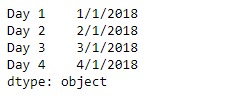Python是进行数据分析的一种出色语言,主要是因为以数据为中心的python软件包具有奇妙的生态系统。 Pandas是其中的一种,使导入和分析数据更加容易。
Pandas 系列是带有轴标签的一维ndarray。标签不必是唯一的,但必须是可哈希的类型。该对象同时支持基于整数和基于标签的索引,并提供了许多方法来执行涉及索引的操作。
Pandas Series.loc属性用于通过给定Series对象中的标签或布尔数组访问一组行和列。
用法:Series.loc
参数:没有
返回:系列
范例1:采用Series.loc属性以根据标签从给定Series对象中选择一些值。
# importing pandas as pd
import pandas as pd
# Creating the Series
sr = pd.Series(['New York', 'Chicago', 'Toronto', 'Lisbon'])
# Creating the row axis labels
sr.index = ['City 1', 'City 2', 'City 3', 'City 4']
# Print the series
print(sr)输出:

现在我们将使用Series.loc属性以返回给定Series对象中所选标签的值。
# return the selected values.
sr.loc[['City 4', 'City 3', 'City 1']]输出:

正如我们在输出中看到的,Series.loc属性已返回其标签已传递给它的城市的名称。
范例2:采用Series.loc属性以根据标签从给定Series对象中选择一些值。
# importing pandas as pd
import pandas as pd
# Creating the Series
sr = pd.Series(['1/1/2018', '2/1/2018', '3/1/2018', '4/1/2018'])
# Creating the row axis labels
sr.index = ['Day 1', 'Day 2', 'Day 3', 'Day 4']
# Print the series
print(sr)输出:

现在我们将使用Series.loc属性以返回给定Series对象中所选标签的值。
# return the selected values.
sr.loc[['Day 4', 'Day 3', 'Day 1']]输出:

正如我们在输出中看到的,Series.loc属性已返回其标签已传递给它的城市的名称。
相关用法
- Python pandas.map()用法及代码示例
- Python Pandas Series.pow()用法及代码示例
- Python Pandas Series.div()用法及代码示例
- Python Pandas Timestamp.tz用法及代码示例
- Python Pandas Timestamp.dst用法及代码示例
- Python Pandas dataframe.sub()用法及代码示例
- Python Pandas Series.abs()用法及代码示例
- Python Pandas Series.sum()用法及代码示例
- Python Pandas Series.all()用法及代码示例
- Python Pandas Index.all()用法及代码示例
- Python Pandas TimedeltaIndex.name用法及代码示例
- Python Pandas Series.str.pad()用法及代码示例
- Python Pandas Timestamp.now用法及代码示例
- Python Pandas Dataframe.pop()用法及代码示例
- Python Pandas Series.mul()用法及代码示例
注:本文由纯净天空筛选整理自Shubham__Ranjan大神的英文原创作品 Python | Pandas Series.loc。非经特殊声明,原始代码版权归原作者所有,本译文未经允许或授权,请勿转载或复制。
